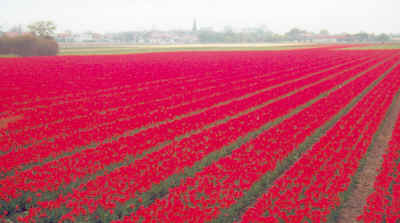|
|
|
Harlan Hague |
My impression of Holland has always been a mélange of canals, polders, pretty villages, tulips and bicycles. Every time I have driven in Holland, I have envied the cyclists who were riding on the dedicated bike lanes off the roads. It seemed the ideal way to see the countryside and villages. I decided that I would plan a trip that would include all my interests.
I began with the bicycling. I searched the web for companies that offered biking holidays and settled on Cycletours Holland, based in Amsterdam. I selected an itinerary north of Amsterdam that included picturesque countryside and villages, and the best tulip fields in the country, for I was purposely scheduling my trip in late April at the height of the tulip season. I would risk the possibility of cool weather and some rain.
My decision to go with Cycletours was influenced by another attraction. Accommodation would be aboard a canal barge. We would be able to unpack once and not repack until the end of the holiday. Breakfast and dinner would be taken aboard the barge, and we would make a picnic lunch each morning after breakfast. After the bicyclists set off, the barge would sail and put in at our next destination.
I was so
enthusiastic about this trip that I decided to put a group together. I recruit for my soft
adventure tours on the web, and it was not long before applications began to come in from
all over the country. Cycletours assigned the recently-refurbished Madeleine for
our exclusive use, and it was soon full with twenty members.
The group met
on the boat at Amsterdam. My wife Carol and I were the last to board. The others had
worried about us, and with good reason. We had stayed the previous night at a delightful
B&B in Diemen, an eastern suburb ten minutes by rail from Amsterdam Central. The Madeleine
was moored at Eastern Dock, a ten-minute walk from the station. On arrival at the station,
instead of consulting the instructions--which I had carefully sent to each member--I asked
directions from a guard. He gave directions without hesitation--all wrong--and we set out.
After walking for thirty minutes, dragging our luggage which was increasing in weight by
the minute, it was obvious that we were lost.
I called a
halt, and we pondered. We stood on the sidewalk beside a six-lane thoroughfare of fast-moving traffic. We were exhausted and worried
that we would be late at the boat. A car stopped on the other side of the road. A woman
got out, made her way through the traffic and walked over to us.
“You look
so forlorn," she said. "Can I help you?” This kind lady took us across the
street, and she and her husband set out to find our boat. She did two illegal U-turns,
changed lanes illegally and finally found Eastern Dock. We didn’t see the Madeleine,
but we did see another barge, whose name I recognized as a Cycletours boat, underway
toward a footbridge. She stopped the car, and we ran onto the bridge.
We thanked our benefactors
profusely and boarded. Ten minutes later, we were underway. We had arrived thirty minutes
late, and I was embarrassed. And a bit stupid. I had read the departure time of 1500 in
the tour instructions as 5:00 p.m. Duh. This was not my first experience with the
24-hour clock. Honest. I simply have the unfortunate habit of being the only member of my
tour groups that does not follow instructions that I send to members. On my Tanzania
safari a few months ago, I was the only person in our group of sixteen who brought a copy
of the yellow fever certificate rather than the original, as required by the instructions
that I had sent to all members. Very embarrassing.
We met the members of our group on the deck and the passageways as we stowed gear in cabins in a sort of ordered confusion. This done, we gathered in the dining hall. Our guide, Ilja Bendeler, welcomed us aboard. Ilja is the founder and president of Cycletours. We had met the previous February when my safari group spent a night in Amsterdam, en route to Tanzania. Ilja was interested in the makeup of the tour and told me that he was going to try to get away and guide us. Now he briefed us on the week’s activities, and we met the crew of two, Els and Winfred, both of whom are certificated skippers and cooks.
I looked
around the room at the tour members. Judging from their talk and apparel, most were
serious bikers. Ominous. Carol and I had biked little for many years.
The skies were dark and threatening, but we had come
to ride, and we began that very evening.
Never mind the weather. We had been warned to expect rain, which would not stop us.
We dressed and
met on deck where we were each assigned a bicycle which would remain ours for the week.
Seats and handlebars were adjusted, and panniers were checked for lock, key, and water
bottle. By this time, the boat had docked at Wormerveer. Bicycles were offloaded, and we
were off in a light rain.
This first
ride was a short one, about five miles through the streets of the town and a connecting
bike path to the wonderful open air museum of Zaanse Schans. We rode beside windmills and
walked among the historic houses and shops of the museum village. A popular stop was the
shop which offered samples and sales of a great variety of cheeses. Then it was back to
the boat, load the bicycles aboard, and dinner.
The next
morning, we made our picnic lunches after breakfast, handed the bikes down to the dock and
set out behind Ilja. We were soon riding through reclaimed land, or polders, that had been
formed by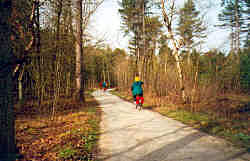 building dikes, pumping out the water,
then managing the water level to keep it dry. We rode through the village of Krommenie
northward to the shores of Alkmaarder Meer and westward, skirting the town of Castricum,
to forests and dunes on the west coast. We stopped for hot drinks and--what
else--Dutch apple pie at a small restaurant. At my request to be served outside, the
waiter said that those tables were not available at the moment, but when I commented on
the heavy tobacco smoke inside, he relented. For the most part, Europeans still
haven’t discovered the benefits of smokeless restaurants, but there is some progress,
more in Britain than on the continent.
building dikes, pumping out the water,
then managing the water level to keep it dry. We rode through the village of Krommenie
northward to the shores of Alkmaarder Meer and westward, skirting the town of Castricum,
to forests and dunes on the west coast. We stopped for hot drinks and--what
else--Dutch apple pie at a small restaurant. At my request to be served outside, the
waiter said that those tables were not available at the moment, but when I commented on
the heavy tobacco smoke inside, he relented. For the most part, Europeans still
haven’t discovered the benefits of smokeless restaurants, but there is some progress,
more in Britain than on the continent.
We rode thirty-three miles this day. It rained most of the day, but it was light and made the riding rather pleasant. Thank goodness for Gore-Tex. This was the longest Carol and I had ever ridden, and the tail bones were beginning to chafe. We had an unplanned stop this day when my bicycle seat fell off. Just fell off. Unfortunately, four guys knew how to put it back together, so eight hands were on the seat for an hour before it was replaced.

The ride ended at Alkmaar,
where the Madeleine awaited us at her mooring. After dinner, Ilja took some of the
group on a walk through the town, a traditional old Dutch village, well-known for its
cheese market and weighing house, canals and neat, picturesque houses, hundreds of which
are registered historic buildings.
The next day,
we rode northward into the forests and high dunes beyond Schoorl and Bergen—no,
Dorothy, Holland is not completely flat. Ilja dropped back occasionally on inclines and
helped Carol along with a hand on her back. The dunes are overgrown with pine trees, low
brushy vegetation and grasses. We stopped at Uitkijkduin, the highest point for a 360º
view and refreshment from our packs. The prominence had been used by the Germans in WWII
as a radar site.
Biking farther northward in the center of the Dutch bulb industry, we saw fields of brilliant color, blue, purple and pink hyacinths, yellow daffodils, and tulips of all colors, red, pink, yellow, vari-colored. We rode along the Hondsbosse Sea Dike, an arrow-straight high dike. Here we had a tailwind that was just about equal to our forward speed, and it seemed that we were riding in a vacuum. We stopped today for coffee and chocolate at a seaside restaurant.
In the village
of Anna Paulowna, named after the wife of a
Russian czar, we strolled in a demonstration
garden where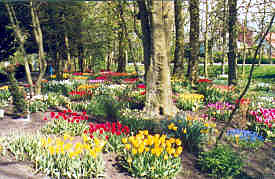 each plot of flowers was labeled with the
name of the flower and the grower. It was wonderful, a miniature Keukenhof.
each plot of flowers was labeled with the
name of the flower and the grower. It was wonderful, a miniature Keukenhof.
The weather
this day was dry and pleasant for the most part, almost warm. Forty-four miles today.
Delightful, but painful to the posterior. The day ended at Den Helder where we boarded the
Madeleine for the crossing to Oudeschild on the island of Texel. The warm shower in
our snug little cabin felt awfully good.
I believed him. At that
moment, it seemed the only plausible explanation. We saw more tulip fields, lots of dunes
and sand, and many bikers and walkers. Texel is a popular holiday spot for the Dutch.
We stopped for
lunch and drinks at a beach restaurant at Ecomare. We found seats behind a wind break and
enjoyed the warm sunshine. 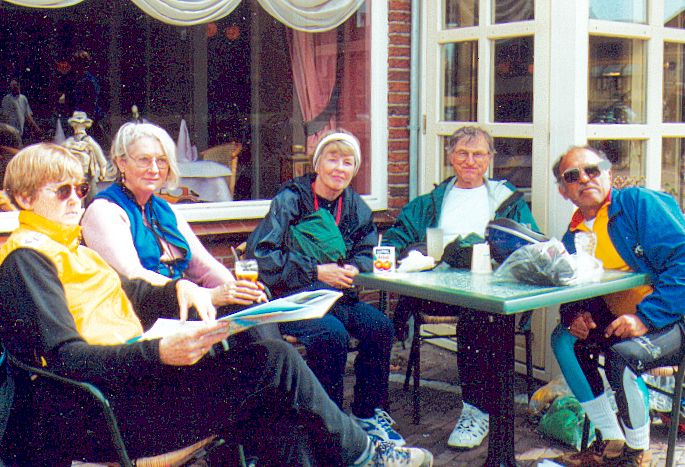 Following lunch, the group
splintered, some taking a long route, others taking a more direct route and my group with
no definite route. We stopped in Den Burg for coffee and a stroll in the busy pedestrian
district of small shops, then continued. From here, it was a straight flat road to
Oudeschild and the Madeleine, but a young boy on the road convinced our group that
we should take a shortcut, which we did. Immediately
it started raining, the road turned upward and forked in three places. At the next
turning, we headed toward the direct route and the Madeleine.
Following lunch, the group
splintered, some taking a long route, others taking a more direct route and my group with
no definite route. We stopped in Den Burg for coffee and a stroll in the busy pedestrian
district of small shops, then continued. From here, it was a straight flat road to
Oudeschild and the Madeleine, but a young boy on the road convinced our group that
we should take a shortcut, which we did. Immediately
it started raining, the road turned upward and forked in three places. At the next
turning, we headed toward the direct route and the Madeleine.
We set off
biking through the IJsselmeer polders, passing more colorful fields of tulips. In one
field, we saw a machine just beginning to cut the tops off the flowers. The machine left a
swath of decapitated stems. I understand that this massacre is necessary to encourage
growth of the bulb. If we had been just a few days later, we would have seen fields of
green stubs rather than riots of color.
We had lunch
in the pretty little seaside town of Medemblik. The café looked out on a secluded harbor
crowded with a forest of sailboat masts. The town at one time was an important seaport,
but now is a pleasure boating center. We strolled around the quay to the
thirteenth-century castle.
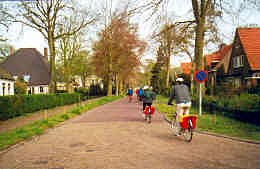 Leaving Medemblik, we cycled along narrow canals to the picturesque
village of Twisk. We rode along the quiet lanes of neat old houses and shops. Carol and I
stopped and watched an interesting procession. A man walked behind a horse, holding long
reins, and another man followed, pulling a sulky. I wondered who was training whom.
Further on, we stopped at a working windmill where the operator explained the process in
operation, grinding grain to flour.
Leaving Medemblik, we cycled along narrow canals to the picturesque
village of Twisk. We rode along the quiet lanes of neat old houses and shops. Carol and I
stopped and watched an interesting procession. A man walked behind a horse, holding long
reins, and another man followed, pulling a sulky. I wondered who was training whom.
Further on, we stopped at a working windmill where the operator explained the process in
operation, grinding grain to flour.
From here, Carol and I fell behind as
we stopped frequently for pictures and rest. Another member of our group dropped behind to
help keep us on the route, and we soon lost sight of the group. So the three of us rode
together, unhurried, cycling to and fro, but always in the general direction of the sea
and finally arrived in Enkhuizen, which is not to say at the Madeleine. We asked a
half dozen people the direction to the waterfront, received conflicting directions, and
after a few zigzags, found the quay. We saw some Cycletours bicycles at the folk museum at
the waterfront, but we continued to the boat. We walked the last hundred yards or so,
looking at the sights, stretching and easing our aching bones.
Enkhuizen is a
pretty little seaside town dating from the fourteenth century. Its harbor was once one of
Holland’s busiest, and the houses and buildings are the result of that thriving
international commerce. Today the town is a popular destination for Dutch and foreign
visitors.
The next day the group rode along the
IJsselmeer coast to Hoorn. Like other seaside towns on the old Zuiderzee, Hoorn was a
flourishing seaport, sending out ships to the Dutch East Indies, the Mediterranean, and
the Americas. The bikers continued down the coast to Schardam, then turned inland to ride
around the huge Eilandspolder, en route visiting the seventeenth-century villages of Graft
and De Rijp. Continuing, the group bicycled eastward to Edam, a pretty village whose round
cheeses are known to cheese lovers the world over, and thence to Volendam.
Alas, I was
not among the bikers on this day. An old eye problem, dating from the days when I wore
contact lenses, erupted and I decided to find other entertainment. Carol was happy to keep
me company.
We mapped out
a day that would end in Volendam. Joined by two women who were not biking, we took the
train from Enkhuizen to Hoorn. We walked through the busy but pleasant streets and had tea
and pastries at an outside café. I also bought an eye bandage and medication at a
pharmacy and was pleased to find an optician where I bought some clipon sunglasses. I had
lost my sunglasses in England where we had spent a few days in Kent,
en route to Holland. We were surprised to see a number of members of our group who were
walking their bikes and sightseeing.
Leaving Hoorn,
we took a bus to Edam. We walked about the town center, sampled some cheeses, and ate our
sack lunches beside a canal. Afterward, we boarded another bus for Volendam. This is a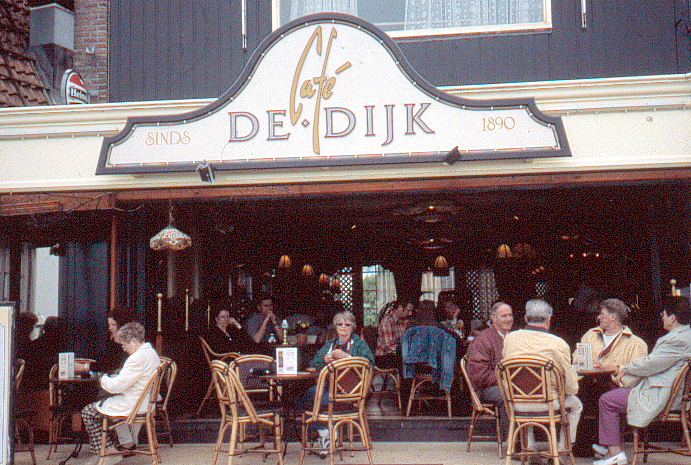 picturesque little seaside town, marred only by the abundance of
visitors. As that erudite philosopher Pogo once said, “we have met the enemy, and he
is us.” We became part of the crowd and enjoyed it anyway. We found the Madeleine
and deposited water bottles, purchases and other superfluous gear, then Carol and I walked
back to a little seaside café I had spotted earlier. We took an outside table overlooking
the harbor. We sat down, I ordered tea and exhaled. We watched the passing boats and
people. This is the best part of traveling. Tea at a sidewalk café with a pleasant view
at the end of a satisfying day.
picturesque little seaside town, marred only by the abundance of
visitors. As that erudite philosopher Pogo once said, “we have met the enemy, and he
is us.” We became part of the crowd and enjoyed it anyway. We found the Madeleine
and deposited water bottles, purchases and other superfluous gear, then Carol and I walked
back to a little seaside café I had spotted earlier. We took an outside table overlooking
the harbor. We sat down, I ordered tea and exhaled. We watched the passing boats and
people. This is the best part of traveling. Tea at a sidewalk café with a pleasant view
at the end of a satisfying day.
The night was
not so restful. Shortly after midnight, a piercing alarm sounded in the passageway.
Everyone was out of their cabin in an instant. I rushed down the hall and up the ladder to
the deck. I expected to see the crew and guide, but no one was in sight. I ran forward in
the darkness to try to find the hatch to Ilja’s cabin, but could not locate it. I
didn’t know the location of the crew’s cabin. Returning to the ladder, I met
Winfred who informed me that the fire alarm does not sound in his quarters, and apparently
not in the guide’s quarters. This is a serious design flaw. The problem seemed to
have something to do with a generator smoking.
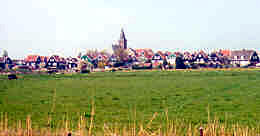 On Friday, my eye was still bothering me a bit, but I was
determined to ride this last day. We left the boat early and biked across the causeway
road to Marken, a pretty village that is worth a visit in spite of its obvious tourist
orientation. At least the inhabitants were not all dressed in ancient garb as they were
when I visited many years ago.
On Friday, my eye was still bothering me a bit, but I was
determined to ride this last day. We left the boat early and biked across the causeway
road to Marken, a pretty village that is worth a visit in spite of its obvious tourist
orientation. At least the inhabitants were not all dressed in ancient garb as they were
when I visited many years ago.
Leaving the
town, we rode a circuitous route on a path atop a dike, bound for the causeway. The narrow
path dropped off sharply on each side. A misstep, or a mispedal in this case, gave one the
option of rolling  fifteen feet down the right
side into a drainage canal, or on the left side into the sea. When the path narrowed to
about twelve inches, I became a bit anxious. Carol later called it nerve-wracking. I
breathed much easier when we reached the road.
fifteen feet down the right
side into a drainage canal, or on the left side into the sea. When the path narrowed to
about twelve inches, I became a bit anxious. Carol later called it nerve-wracking. I
breathed much easier when we reached the road.
We walked from
the ferry landing through the train station to Eastern Dock where the Madeleine was
moored, thus discovering the route that we should have taken that first day. We turned in
our bikes, cleaned up, began packing, and enjoyed a nice farewell dinner. It was the end
of a challenging, exhausting, and rewarding holiday.
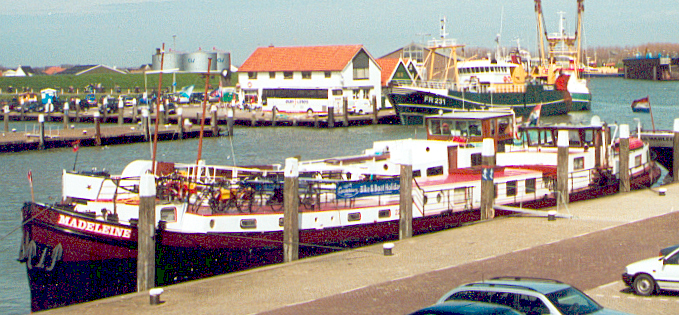 The Madeleine was as expected and advertised. It was
convenient, comfortable and, for a complement of twenty passengers, not cramped. The
cabins were snug, but manageable. The dining area was airy, light and spacious. The food
was ample and tasty. Els and Winfred did a commendable job, cooking and managing the
barge.
The Madeleine was as expected and advertised. It was
convenient, comfortable and, for a complement of twenty passengers, not cramped. The
cabins were snug, but manageable. The dining area was airy, light and spacious. The food
was ample and tasty. Els and Winfred did a commendable job, cooking and managing the
barge.
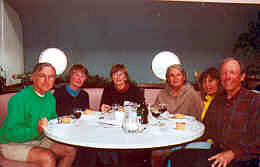 I heartily recommend the bike and boat experience. It
was great fun. If you decide to consider a like holiday, be prepared. Get ready for biking
by biking. Riding a few blocks two or three times a week won’t do it. I speak from
experience. Ride on a regular basis until you can do twenty miles without cardiac
arrest. Take the right gear. Consult with serious riders and bike shops. If you’re
going to Holland, be sure to pack good rain gear. It will rain.
I heartily recommend the bike and boat experience. It
was great fun. If you decide to consider a like holiday, be prepared. Get ready for biking
by biking. Riding a few blocks two or three times a week won’t do it. I speak from
experience. Ride on a regular basis until you can do twenty miles without cardiac
arrest. Take the right gear. Consult with serious riders and bike shops. If you’re
going to Holland, be sure to pack good rain gear. It will rain.
Be sure you understand the nature of the daily routine, that is, whether this is a bike ride in a region, or an exploration of a region by bike. There is a difference. If the former, you might as well bike at home. Will there be pauses for the view and photos, stops at pleasant cafés and tea rooms for refreshment, leisurely rides and walks through picturesque villages? I recommend this sort of experience. Be sure that the bike is part, not the end, of the experience.
Be sure you understand clearly the distances that will be covered each day. Talk with your group leader, and/or correspond with the company or guide to be sure you won’t be surprised with a change to a more ambitious schedule. The guide can outline an optional more challenging route for the serious bikers who can go off on their own with a detailed map. Be sure the guide has a method for ensuring that no one in the group is left behind.
All members of the group need not bike. Three women in our group stayed aboard the Madeleine as it moved to our next destination. Individual bikers occasionally opted to sit out a day to recover from the ravages of a hard bicycle seat or other ailments, or simply to enjoy the cruising. On mooring, those remaining aboard usually debarked to visit the town. Occasionally some took a train or bus to a nearby attraction. And they simply enjoyed the leisure of reading and relaxing on board.
There are a number of companies, both American and foreign, that arrange biking holidays. I opted for Cycletours because it offered precisely the sort of experience that I wanted. Our cost was about US$650 land, Saturday to Saturday, which included accommodation and all meals, a Gazelle Medeo 21-speed hybrid bike, and a multilingual guide. In addition to a number of bike and boat itineraries in Holland, Cycletours offers biking tours throughout the world. For all of their tours, Holland and elsewhere, contact Cycletours International, Keizersgracht 181, 1016DR Amsterdam. Telephone 31 20 6262601, fax 31 20 6269024, email cyclefun@cycletours.com or cti@cycletours.com. Ask for a brochure, or visit their web site at http://www.cycletours.com,.
If you need accommodation, I highly recommend the B&B where we stayed in Diemen. Book through Jim Kloos, klooskdl@worldonline.nl, a general booking agent based in Amsterdam, for accommodation and tours. Mick Halvers’s home is an easy five-minute walk from the small train station in Diemen, which is but ten minutes ride from Amsterdam Central station. The immaculate house is on a quiet street, and only about a ten-minute walk to cafes and shops. Ask for the upper room overlooking the back garden. The included breakfast is taken in a pleasant dining room overlooking the garden. Mick is welcoming and friendly and very helpful with suggestions. Our cost was NLG57.50 per person per night, about US$25.00. For me, this delightful B&B compares favorably to most accommodations in Amsterdam.
If you would prefer accommodation in central Amsterdam, I highly recommend the Canal House Hotel, a small seventeenth-century hotel in a quiet residential quarter, near the Anne Frank House, Dam Square, the West Church, and the Royal Palace. Furnishings are seventeenth century-style, and the atmosphere is informal. Private baths and all the modern conveniences, including laptop connections, but no television. Intimate lounge and elegant dining room. From US$122 double. Keizersgracht 148, 1015 CX, Amsterdam, NC. Tel. 31 20 6225182, fax 31 20 6241317, info@canalhouse.nl, http://www.canalhouse.nl.
|
Caveat and disclaimer: This is a freelance travel article that I published some time ago. Some data, especially prices, links and contact information, may not be current. |
|
|
|
|
